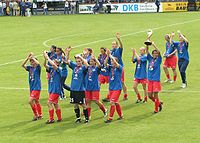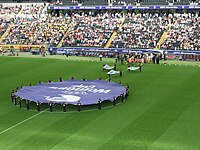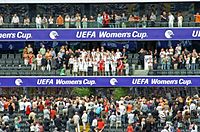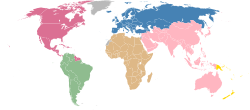UEFA Women's Champions League
 | |
| Organising body | UEFA |
|---|---|
| Founded | 2001 |
| Region | Europe |
| Number of teams | 16 (group stage) 72 (total) |
| Related competitions | UEFA 2nd tier |
| Current champions | |
| Most successful club(s) | |
| Television broadcasters | DAZN beIN Sports (MENA only) |
| Website | uefa.com/womenschampionsleague |
The UEFA Women's Champions League, previously called the UEFA Women's Cup (2001–2009), is a European women's association football competition. It involves the top club teams from countries affiliated with the European governing body UEFA.
| Season | UEFA Women's Cup |
|---|---|
| 2001–02 | |
| 2002–03 | |
| 2003–04 | |
| 2004–05 | |
| 2005–06 | |
| 2006–07 | |
| 2007–08 | |
| 2008–09 | |
| Season | UEFA Women's Champions League |
| 2009–10 | |
| 2010–11 | |
| 2011–12 | |
| 2012–13 | |
| 2013–14 | |
| 2014–15 | |
| 2015–16 | |
| 2016–17 | |
| 2017–18 | |
| 2018–19 | |
| 2019–20 | |
| 2020–21 | |
| 2021–22 | |
| 2022–23 | |
| 2023–24 |
The competition was first played in 2001–02 under the name UEFA Women's Cup, and renamed the Champions League for the 2009–10 edition. The most significant changes in 2009 were the inclusion of runners-up from the top eight ranked nations, a one-off final as opposed to the two-legged finals in previous years, and – until 2018 – playing the final in the same city as the men's UEFA Champions League final. In the 2021–22 season, the competition proper included a group stage for the first time in the Women's Champions League era.
Lyon is the most successful club in the competition's history, winning the title eight times, including five consecutive titles from 2016 to 2020. Barcelona are the current champions, having beaten Lyon in the 2024 final.
The idea of creating two new women's European Cups is regularly raised to offer more matches.[1]
Format
[edit]UEFA Women's Cup (2001–2009)
[edit]For the tournament's first 3 editions, a preliminary round was first played to reduce teams to 32. Starting in the second season, this stage grouped teams into mini-tournaments of four teams, whose winners advanced to the second qualifying round, sometimes called the group stage. The group stage was eight groups of four, each group held as a round-robin in a single country, whose winners advanced to the quarter-finals.
From the 2004–05 season, the first qualifying stage was expanded to 9 groups of 4, again playing a round-robin in a single location. Seven teams got a bye to the group stage. (in 2007–08, it was 10 groups of 4, advancing winners plus one runner-up, with 5 teams getting a bye). The group stage was then played among only 16 teams in four groups of four, each group in a single host country, with the top two teams in each group advancing to the quarter-finals.
The knock-out rounds were played as two-legged home-and-home matches, including the final (except for the first final).
Champions League (2009–2021)
[edit]On 11 December 2008, UEFA announced that the competition would be reformatted and renamed to the UEFA Women's Champions League beginning with the 2009-10 competition.[2] As in the men's game, the new tournament aimed to include runners-up of the top women's football leagues in Europe.[3]
The competition was opened to the champions of all 55 UEFA associations that had a qualifying women's league. Due to the varying participation, the number of teams playing the qualifying round changed from year to year.[4] Numbers were based on three principles:
- Qualifying rounds are contested by groups of 4 teams.
- Group winners, plus the smallest possible number of runners-up, qualify for the Round of 32.
- Teams from the top associations would enter directly into the Round of 32.
Competition from the Round of 32 onwards would be in the form of home-and-home pairings using the away goals rule, except for the single-legged final.
Minor adjustments
[edit]When the new format was initially announced, the eight top countries according to the UEFA league coefficient were awarded two places in the league,[3] with runners-up participating in the qualifying rounds.
For the 2011–12 tournament, the runners-up from the top eight nations instead qualified directly to the R32. For the five years under this format, seven nations remained in the top eight: Germany, Sweden, England, France, Denmark, Russia, and Italy. A different nation provided the eighth runner-up in each of the five years: Iceland, Norway, Austria, Czech Republic,[5] and Spain[6] in that order.
The tournament was expanded for the 2016–17 season, with the runners-up from nations 9–12 in UEFA league coefficient also qualifying. For the first three years under this format, the four nations in these slots were Czech Republic, Austria, Scotland, and Norway. For the 2019–20 season, Switzerland replaced Norway, and for the final season under this format, Norway, Kazakhstan, and The Netherlands replaced Russia, Scotland, and Austria in the top 12.
In all 11 editions of the competition under this general format, qualifying rounds consisted of between 7 and 10 groups-of-4, advancing qualifying-group winners plus 0-2 top-ranked runners-up, varying year to year based on team counts. The number of teams entering at the Round of 32 also varied slightly, between 20-25.
The COVID-19 pandemic forced a slight restructuring of the 2019-20 and 2020-21 competitions. At the start of the pandemic the Round of 16 had been completed; the quarterfinals and on were delayed and eventually played as single-legged matches in the summer of 2020. The qualifying rounds of the 2020-21 competition switched to single-legged matches, with 20 pairings of teams in the first round and 10 pairings in the second round, the winners joining 22 top teams in the Round of 32, which was normal from that point on aside from most matches being played behind closed doors.
Champions League (2021–2025)
[edit]On 4 December 2019, a new format was announced starting with the 2021–22 season.[7] The top six associations entered three teams, associations ranked 7–16 entered two, and the remaining associations entered one. The competition is restructured to appear more similar to the men's CL format, with a double-round-robin group stage, and two paths through the qualifiers (a champions path and a non-champions path) for teams that do not automatically qualify for the group stage. UEFA also centralized the media rights from the group stage onward.[8]
- Qualification takes place in two rounds: a First Round of 3- or 4-team mini-tournaments with single elimination brackets, and a Second Round of two-legged matches. Each of these rounds is split into two simultaneous paths based on how teams qualified:
- The Champions path consists of the champions from the associations ranked 8-50. 7 teams advance.
- The League path consists of the runners-up from the top 16 associations and third-place teams from the top 6 associations. 5 teams advance.
- The Group stage includes four teams qualifying directly: the defending UWCL champions and the champions from the top 3 associations. It is played in four groups of four, each advancing two teams to two-legged quarterfinals.
| Teams entering in this round | Teams advancing from the previous round | ||
|---|---|---|---|
| First round August |
Champions Path (44 teams) |
|
|
| League Path (16 teams) |
| ||
| Second round Aug/Sept |
Champions Path (14 teams) |
|
|
| League Path (10 teams) |
|
| |
| Group stage (16 teams) Oct/Nov/Dec |
|
| |
| Knockout phase (8 teams) Mar/Apr/May |
| ||
Champions League (2025–)
[edit]On 4 December 2023, a new format was announced starting with the 2025–26 season.[9] The top seven associations enter three teams, associations ranked 8–17 enter two, and the remaining associations enter one. The competition is restructured to appear more similar to the men's CL format, with a Swiss-system 'league phase' consisting of 6 games against 6 different opponents (3 home and 3 away), and two paths (a champions path and a non-champions path) for teams that do not automatically qualify for the league stage.
- Qualification takes place in two separate paths of up to three rounds.
- The Champions path consists of the domestic champions from associations ranked seventh or below as well as the previous season's second competition winner with 4 teams advancing to the league stage. A preliminary round and first round are played as series of four-team mini-tournaments while the second round is played as two-legged ties.
- The League path consists of domestic runners-up from associations ranked fourth to seventeenth and domestic third-placed teams from associations ranked first to seventh. A first round is played as a series of four-team mini-tournaments, while the second round is played as two-legged ties.
- Losers from the second round ties and runners-up and third-placed teams in the first round mini-tournaments will transfer to the as-yet unnamed second competition, while fourth-placed teams in the first round mini-tournaments and all losers from the preliminary round mini-tournaments will be eliminated.
- The League stage consists of nine teams qualifying directly: The defending champions, domestic champions from the associations ranked sixth or higher as well as the domestic runners-up from the top two associations.
- The top four teams from the league stage will advance to the quarter-finals while teams ranked fifth to twelfth will qualify to a knockout play-off round. The remaining six teams are eliminated.
| Teams entering in this round | Teams advancing from the previous round | ||
|---|---|---|---|
| Preliminary round | Champions path (24 teams) |
| |
| First round | Champions path (28 teams) |
|
|
| League path (16 teams) |
|
||
| Second round | Champions path (8 teams) |
|
|
| League path (10 teams) |
|
| |
| League stage (18 teams) |
|
| |
| Knockout round play-offs (8 teams) |
| ||
| Knockout phase (8 teams) |
|
| |
Prize money
[edit]Prize-money was awarded for a first time in 2010, when both finalists received money. In 2011 the payments were extended to losing semi- and quarter-finalists.[11] In these earlier years, teams sometimes complained about the sum, which did not cover costs for some longer trips.[12] The 2021–22 Women's Champions League introduced a 16-team group stage to the competition, and with it a vastly expanded prize pool of €24M total. Of that pool, €5.6M (23%) would be used for solidarity payments to non-participating clubs of participating countries, to provide funding for development. €7M (29%) would be reserved for the qualifying rounds (some of which is travel subsidies for clubs traveling long distances), and the €11.5 remainder (48%) would be for clubs reaching the group stage and later.[13]
For the main portion of the competition, UEFA announced that each group-stage participant would receive a minimum of €400,000 (about five times as much as Round of 16 participants received in previous editions). The winner of the tournament could earn up to €1.4 million (depending on its results in the group stage).[14][15] As of the 2023–24 competition, the prize-money structure for the competition proper is as follows:[16]
- €400,000 base allocation for each group-stage team
- €50,000 per win in the group stage, and €17,000 per draw
- €20,000 bonus for winning their group
- €160,000 for qualification for the quarter-finals
- €180,000 for qualification for the semi-finals
- €200,000 for the runner-up
- €350,000 for the winning team
This is in addition to any money teams may receive for participating in the qualifying rounds, and each stage's prize is cumulative. These amounts remain the same as those for the 2021–22[17][18] and 2022–23 competitions.[19] After the conclusion of the group stage, some additional amounts held in reserve may be distributed depending on the competition's financial performance, and how many drawn matches there were in the group stage.
Sponsorship
[edit]Until the 2015–18 cycle, UEFA Women's Champions League used to have the same sponsors as the UEFA Champions League. Since 2018, women's football competitions such as the Champions League have separate sponsors.[20] The tournament has centralised rights: in the group stage, only some assets and the official ball are centralised, while in knock-out rounds, UEFA started allowing only a few club sponsors, alongside the ones who are official.[21]
As of 2024, official sponsors are:
- Adidas[22]
- Amazon[23]
- EA Sports FC[24]
- Euronics[25]
- Grifols[26]
- Heineken[27]
- Hublot[28]
- Just Eat Takeaway[29]
- PepsiCo[30]
- PlayStation[31]
- Visa[32]
Records and statistics
[edit]Winners
[edit]| Club | Titles | Runners-up | Seasons won | Seasons runner-up |
|---|---|---|---|---|
| 8 | 3 | 2011, 2012, 2016, 2017, 2018, 2019, 2020, 2022 | 2010, 2013, 2024 | |
| 4 | 2 | 2002, 2006, 2008, 2015 | 2004, 2012 | |
| 3 | 2 | 2021, 2023, 2024 | 2019, 2022 | |
| 2 | 4 | 2013, 2014 | 2016, 2018, 2020, 2023 | |
| 2 | 3 | 2003, 2004 | 2002, 2007, 2008 | |
| 2 | 2 | 2005, 2010 | 2006, 2011 | |
| 1 | 0 | 2007 | ||
| 1 | 0 | 2009 | ||
| 0 | 2 | 2015, 2017 | ||
| 0 | 1 | 2003 | ||
| 0 | 1 | 2005 | ||
| 0 | 1 | 2009 | ||
| 0 | 1 | 2014 | ||
| 0 | 1 | 2021 |
By nation
[edit]| Nation | Winners | Runners-up | Semi-finalists | Winner | Runners-up | Semi-finalists |
|---|---|---|---|---|---|---|
| 9 | 8 | 10 |
|
|
| |
| 8 | 5 | 9 |
|
|
| |
| 3 | 2 | 2 |
|
|
| |
| 2 | 5 | 4 |
|
|
| |
| 1 | 1 | 12 |
|
|
| |
| 0 | 1 | 3 |
|
| ||
| 0 | 1 | 0 |
|
|||
| 0 | 0 | 2 |
| |||
| 0 | 0 | 1 |
| |||
| 0 | 0 | 1 |
|
During the first Champions League era with no group stage (2009–2021), no team from a nation outside the top two of France and Germany won the title, except for Barcelona in 2021. The only teams from nations outside the top two nations to have finished runner-up in that time were Tyresö in 2014, Barcelona in 2019 and Chelsea in 2021. Also during that era, only two teams from a nation outside the top four (then France, Germany, Sweden, and England) ever made the semi-finals: Brøndby in 2015 and Barcelona in four of the last five years under that format.
Top scorers by tournament
[edit]The top-scorer award is given to the player who scores the most goals in the competition. Up until the introduction of the Champions League Group Stage it included the qualifying rounds. Since 2021–22 only goals from the group stage onwards count towards the award. Iceland's Margrét Lára Vidarsdóttir has won the award three times. Ada Hegerberg holds the record for most goals in a season.
| Season | Top scorer(s) (Club) | Goals |
|---|---|---|
| 2023–24 | 8 | |
| 2022–23 | 9 | |
| 2021–22 | 11 | |
| 2020–21 | 6 | |
| 2019–20 | 10 | |
| 2018–19 | 8 | |
| 2017–18 | 15 | |
| 2016–17 | 8 | |
| 2015–16 | 13 | |
| 2014–15 | 14 | |
| 2013–14 | 11 | |
| 2012–13 | 11 | |
| 2011–12 | 9 | |
| 2010–11 | 13 | |
| 2009–10 | 11 | |
| 2008–09 | 14 | |
| 2007–08 | 9 | |
| 2006–07 | 9 | |
| 2005–06 | 11 | |
| 2004–05 | 14 | |
| 2003–04 | 11 | |
| 2002–03 | 10 | |
| 2001–02 | 12 |
All-time top scorers
[edit]- As of 16 October 2024[33] Bold players still active.
| Rank | Topscorer | Goals | Clubs |
|---|---|---|---|
| 1 | 64 | Stabæk, Turbine Potsdam, Olympique Lyon | |
| 2 | 51 | Turbine Potsdam, FC Rosengård, Paris Saint-Germain, Wolfsburg | |
| 3 | 48 | Olympique Lyon | |
| 48 | Turbine Potsdam, 1. FFC Frankfurt, Wolfsburg | ||
| 5 | 46 | Umeå IK, Tyresö FF, FC Rosengård | |
| 6 | 43 | Montpellier, Olympique Lyon | |
| 43 | Hibernian, Arsenal | ||
| 8 | 42 | Olympique Lyon, FC Rosengård | |
| 9 | 40 | SV Neulengbach | |
| 10 | 39 | Linköping, Wolfsburg, Chelsea, Bayern Munich | |
| 39 | Umeå IK |
Awards
[edit]Player of the Season
[edit]Starting from the 2021–22 edition, UEFA introduced the UEFA Women's Champions League Player of the Season award.
The jury is composed of the coaches of the clubs that participated in the group stage of the competition, as well as journalists selected by the European Sports Media (ESM) group.
| Season | Player | Club |
|---|---|---|
| UEFA Women's Champions League Player of the Season | ||
| 2021–22 | ||
| 2022–23 | ||
| 2023–24 | ||
Young Player of the Season
[edit]In the same season, UEFA also introduced the UEFA Women's Champions League Young Player of the Season award.
| Season | Player | Club |
|---|---|---|
| UEFA Women's Champions League Young Player of the Season | ||
| 2021–22 | ||
| 2022–23 | ||
| 2023–24 | ||
International broadcasters
[edit]Global
[edit]DAZN have the global (exc. MENA) rights of the competition from 2021–22 until 2024–25, 61 matches in both 2021–22 and 2022–23 seasons were live streamed for free on the DAZN UEFA Women's Champions League YouTube channel.[34]
UK, Ireland, and Five Latin American countries
[edit]Warner Bros Discovery's channel TNT Sports also cover the competition for 2023-24 season for viewers in Argentina, Brazil, Mexico, Colombia, Chile, Ireland, and UK.
MENA
[edit]All matches from group stage until final will be aired live on beIN Sports until 2023–24 season.
Gallery
[edit]-
2005 champions
-
2008 final
-
2008 final score
-
2008 champions
-
2012 final
See also
[edit]References
[edit]- ^ "Europa League-style competition for women's football among proposals from European Club Association". skysports.com. Retrieved 19 March 2023.
- ^ "Women's Champions League launches in 2009". UEFA.com. Union of European Football Associations. 11 December 2008. Archived from the original on 17 July 2015. Retrieved 8 May 2009.
- ^ a b "Women's Champions League details confirmed" (PDF). UEFA.com. Union of European Football Associations. Archived (PDF) from the original on 20 October 2012. Retrieved 8 May 2009.
- ^ "Access list for the 2014/15 season" (PDF). UEFA.com. Union of European Football Associations. Archived (PDF) from the original on 6 July 2014. Retrieved 5 June 2014.
- ^ "UEFA Women's Champions League association coefficient rankings: places for the 2013/14 season" (PDF). UEFA.com. Union of European Football Associations. Archived (PDF) from the original on 12 November 2012. Retrieved 7 August 2015.
- ^ "Access List for the UEFA Women's Champions League 2015/16" (PDF). UEFA.com. Union of European Football Associations. Archived (PDF) from the original on 5 September 2015. Retrieved 7 August 2015.
- ^ "Game changer: group stage for UEFA Women's Champions League". UEFA.com. Union of European Football Associations. 4 December 2019. Archived from the original on 5 December 2019. Retrieved 4 December 2019.
- ^ "New Women's Champions League format with group stage: how it will work". UEFA.com. Union of European Football Associations. 4 December 2019. Archived from the original on 21 September 2020. Retrieved 4 December 2019.
- ^ "New UEFA Women's club football system explained". UEFA.com. Union of European Football Associations. 4 December 2023. Archived from the original on 4 December 2023. Retrieved 4 December 2023.
- ^ "Provisional access list for the UEFA Women's Champions League and 2nd competition 2025/26" (PDF). uefa.com. UEFA. Archived (PDF) from the original on 7 December 2023. Retrieved 6 December 2023.
- ^ "UEFA Women's Champions League factsheet" (PDF). UEFA.com. Union of European Football Associations. Archived (PDF) from the original on 8 January 2012. Retrieved 21 January 2013.
- ^ "British teams competing in Women's Champions League receive 'farcical' funding from Uefa". The Daily Telegraph. 6 October 2013. Archived from the original on 12 January 2022. Retrieved 9 October 2013.
- ^ Theodoridis, Theodore. "2022/23 UEFA Women's Champions League Schedule of payments to participating clubs" (PDF). UEFA. Retrieved 7 January 2024.
- ^ "UEFA Women's Champions League: Financial distribution model central to European game's drive for sustainability". UEFA. 27 April 2021. Retrieved 7 January 2024.
- ^ Schuller, Rudi (13 May 2021). "HOW MUCH PRIZE MONEY DO THE UEFA WOMEN'S CHAMPIONS LEAGUE WINNERS GET?". DAZN. Retrieved 22 August 2021.
- ^ Theodoridis, Theodore (17 July 2023). "Distributions to clubs from the 2023/24 UEFA Women's Champions League" (PDF). UEFA. Retrieved 7 January 2024.
- ^ Theodoridis, Theodore (26 July 2021). "Distributions to clubs from the 2021/22 UEFA Women's Champions League" (PDF). UEFA. Retrieved 7 January 2024.
- ^ Savage, Will (14 May 2022). "Women's Champions League prize money breakdown: How much do the winners get in 2022?". The Sporting News. Retrieved 1 October 2023.
- ^ Theodoridis, Theodore. "2022/23 UEFA Women's Champions League Schedule of payments to participating clubs" (PDF). UEFA. Retrieved 7 January 2024.
- ^ "UEFA unbundles sponsorship rights for women's competitions". UEFA.com. Union of European Football Associations. 15 November 2017. Archived from the original on 27 December 2017. Retrieved 27 May 2021.
- ^ "UEFA Documents". documents.uefa.com. Archived from the original on 2 May 2021. Retrieved 25 October 2021.
- ^ "adidas Kick Off Partnership with WUCL Ahead of the 2021/22 Champions League Group Stages". VERSUS. 13 September 2021. Retrieved 15 September 2021.
- ^ UEFA.com (2 June 2023). "Amazon becomes UEFA Women's Football partner | UEFA Women's Champions League". UEFA.com. Retrieved 3 May 2024.
- ^ UEFA.com (19 October 2022). "EA SPORTS becomes UEFA Women's Football partner". UEFA.com. Retrieved 3 May 2024.
- ^ UEFA.com (20 May 2021). "Euronics Group becomes official sponsor of UEFA Women's Football | Inside UEFA". UEFA.com. Retrieved 20 May 2021.
- ^ UEFA.com (14 July 2021). "Grifols becomes official partner of UEFA Women's Football | Inside UEFA". UEFA.com. Retrieved 16 July 2021.
- ^ UEFA.com (26 August 2021). "Heineken becomes official partner of UEFA Women's Football | Inside UEFA". UEFA.com. Retrieved 29 August 2021.
- ^ UEFA.com (23 February 2020). "Hublot becomes official partner of UEFA Women's EURO 2021 | Inside UEFA". UEFA.com. Archived from the original on 26 May 2020. Retrieved 24 February 2020.
- ^ UEFA.com (22 March 2021). "Just Eat Takeaway.com to sponsor UEFA Champions League & UEFA Women's EURO in wide-ranging partnership | Inside UEFA". UEFA.com. Retrieved 20 May 2021.
- ^ UEFA.com (26 August 2020). "PepsiCo signs 5-year deal to sponsor UEFA Women's football | Inside UEFA". UEFA.com. Retrieved 27 August 2020.
- ^ UEFA.com (21 March 2023). "PlayStation® becomes official partner of UEFA Women's Football". UEFA.com. Retrieved 3 May 2024.
- ^ "Visa signs ground-breaking seven-year women's football deal with UEFA". UEFA.com. Union of European Football Associations. 6 December 2018. Archived from the original on 6 December 2018. Retrieved 27 May 2021.
- ^ "Hegerberg reigns as all-time top scorer". UEFA.com. Union of European Football Associations. 16 October 2024. Archived from the original on 11 October 2017. Retrieved 17 October 2024.
- ^ "DAZN and YouTube to stream Women's Champions League". UEFA. 30 June 2021. Retrieved 30 June 2021.






